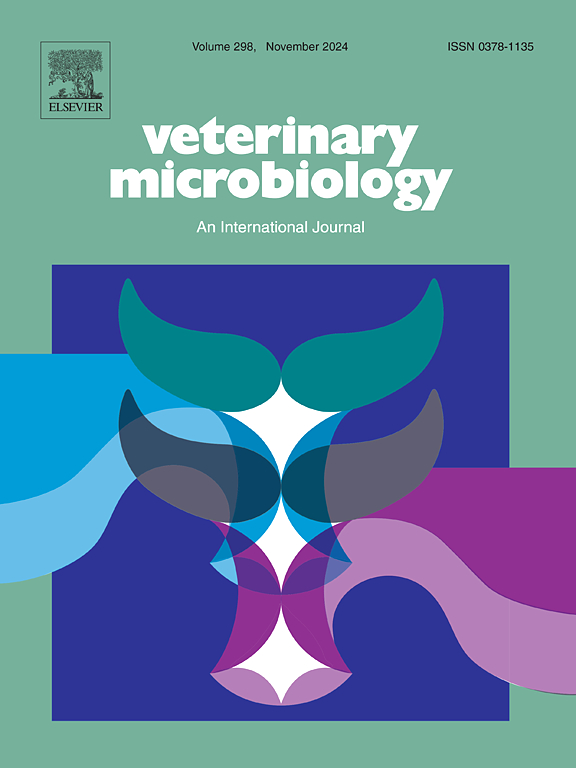肯塔基州中部马匹轮状病毒 B 爆发的流行病学调查。
IF 2.4
2区 农林科学
Q3 MICROBIOLOGY
引用次数: 0
摘要
通过元基因组测序,我们在 2021 年产驹季节爆发的马驹腹泻中发现了反刍动物来源的马轮状病毒 B 组(ERVB)。为了进一步调查 ERVB 的发生情况并确定其环境稳定性,我们在 2022 年的产驹季节收集了肯塔基州中部不同农场的母马和马驹粪便样本。基于 RT-qPCR 的分析表明,在调查的母马样本中有 16.67 %(42/252)和马驹样本中有 26.56 %(34/128)检测到 ERVB 基因组。此外,从ERVB阳性农场采集的94.12%(16/17)的土壤样本和100%(13/13)的水样本也检测出弱阳性。此外,在疫情爆发期间从设备/谷仓/医院病房采集的室内样本中,有 58.33 %(7/12)的样本检测到 ERVB 基因组片段。最后,血清流行率研究显示,87%(113/130)的马血清样本中ERVB抗体呈阳性。尽管ERVB的培养尝试并不成功,但系统进化分析表明,代表2022年和2023年马驹腹泻疫情的粪便ERVB毒株与2021年的毒株一样,与反刍轮状病毒B的亲缘关系比其他病毒更近。进一步的序列分析表明,在过去三年中流行的ERVB毒株中,病毒中和抗体的主要靶标--三种病毒外壳蛋白都没有出现明显的变异。我们的数据表明,ERVB 在受影响马场的马匹中普遍存在,且在马场环境中极为稳定。这些发现继续支持了今后对马匹和周围环境中的 ERVB 进行监测的必要性,以及开发有效对策保护马匹免受这种新型病毒性疾病侵害的必要性。本文章由计算机程序翻译,如有差异,请以英文原文为准。
Epidemiological investigation of equine rotavirus B outbreaks in horses in central Kentucky
Using metagenomic sequencing we identified equine rotavirus group B (ERVB) of ruminant origin in foal diarrhea outbreaks in the 2021 foaling season. To further investigate ERVB occurrence and determine its environmental stability, we collected mare and foal fecal samples from different farms in Central Kentucky during the 2022 foaling season. The RT-qPCR-based analyses showed that ERVB genome was detected in 16.67 % (42/252) of surveyed mare samples and 26.56 % (34/128) of foal samples. Furthermore, 94.12 % (16/17) of collected soil samples and 100 % (13/13) of water samples obtained from the ERVB-positive farm premises also tested weakly positive. In addition, ERVB genome fragments were detected in 58.33 % (7/12) of indoor samples collected from the equipment/barn/hospital wards during the outbreak period. Finally, the seroprevalence study showed 87 % (113/130) of surveyed horse serum samples were positive for ERVB antibodies. Despite unsuccessful attempts in ERVB cultivation, phylogenetic analyses showed that fecal ERVB strains representing 2022 and 2023 foal diarrhea outbreaks, like 2021 strains, were more closely related to ruminant rotavirus B than other viruses. Further sequence analyses revealed that none of the three viral capsid proteins, the primary targets of virus-neutralizing antibodies, exhibited notable mutations among ERVB strains circulated over the past three years. Our data demonstrated that ERVB was widespread in horses on affected farms with extreme stability in the farm environment. These findings continue to support the need for future surveillance of ERVB in horses and the surrounding environment, and the development of effective countermeasures to protect horses against this new viral disease.
求助全文
通过发布文献求助,成功后即可免费获取论文全文。
去求助
来源期刊

Veterinary microbiology
农林科学-兽医学
CiteScore
5.90
自引率
6.10%
发文量
221
审稿时长
52 days
期刊介绍:
Veterinary Microbiology is concerned with microbial (bacterial, fungal, viral) diseases of domesticated vertebrate animals (livestock, companion animals, fur-bearing animals, game, poultry, fish) that supply food, other useful products or companionship. In addition, Microbial diseases of wild animals living in captivity, or as members of the feral fauna will also be considered if the infections are of interest because of their interrelation with humans (zoonoses) and/or domestic animals. Studies of antimicrobial resistance are also included, provided that the results represent a substantial advance in knowledge. Authors are strongly encouraged to read - prior to submission - the Editorials (''Scope or cope'' and ''Scope or cope II'') published previously in the journal. The Editors reserve the right to suggest submission to another journal for those papers which they feel would be more appropriate for consideration by that journal.
Original research papers of high quality and novelty on aspects of control, host response, molecular biology, pathogenesis, prevention, and treatment of microbial diseases of animals are published. Papers dealing primarily with immunology, epidemiology, molecular biology and antiviral or microbial agents will only be considered if they demonstrate a clear impact on a disease. Papers focusing solely on diagnostic techniques (such as another PCR protocol or ELISA) will not be published - focus should be on a microorganism and not on a particular technique. Papers only reporting microbial sequences, transcriptomics data, or proteomics data will not be considered unless the results represent a substantial advance in knowledge.
Drug trial papers will be considered if they have general application or significance. Papers on the identification of microorganisms will also be considered, but detailed taxonomic studies do not fall within the scope of the journal. Case reports will not be published, unless they have general application or contain novel aspects. Papers of geographically limited interest, which repeat what had been established elsewhere will not be considered. The readership of the journal is global.
 求助内容:
求助内容: 应助结果提醒方式:
应助结果提醒方式:


